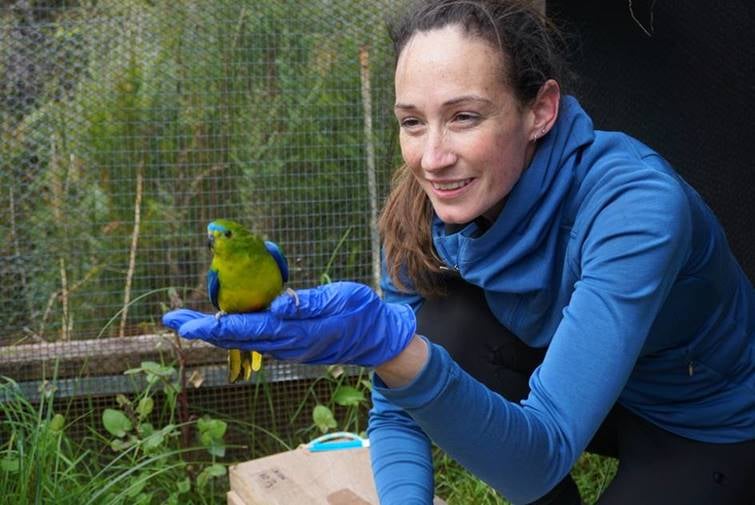On World Environment Day we pay tribute to the vital work of the working people driving the Orange-Bellied Parrot Tasmanian Program team, part of the Department of Primary Industries, Parks, Water and Environment.
Their work is central to the survival of this tiny but determined species, which is critically endangered and much adored in our state and beyond.
Currently there are more than 300 birds at the Five Mile Beach facility. The majority of the birds are currently in holding flights prior to pairing ahead of the breeding season in a few months’ time.
This colourful, tiny bird faces plenty of threats – habitat loss, small population, predators and competitors and disease to name a few.
We spoke with Wildlife Officer Kelly Waterlow about the program and the wonderful parrots they work so had to protect:
“They’re little troopers. If it wasn’t for the captive insurance program, the OBP would be extinct. If we didn’t intervene and release birds at Melaleuca – the Orange-Bellied Parrot would no longer be seen in the wild.”
Kelly Waterlow, Wildlife Officer – Orange Bellied Parrot Program
Kelly is a relative new comer to the OBP Program having started in January, but is no stranger to this field of work, with a background caring for animals at Taronga and WILD LIFE Sydney Zoo and Melbourne Zoo.

Kelly Waterlow, Wildlife Officer – Orange Bellied Parrot Program

(Image: Zoos Victoria)

Photo: Wildlife Biologist Dr Shannon Troy releases an OBP into the pre-release aviary at Melaleuca during the third and final spring release at Melaleuca for 2020. Picture by Sally Simco (DPIPWE volunteer – Facebook).
“In the last 10 years I’ve worked for zoos or in conservation or in ecological roles. From when I was younger, I always loved animals and always wanted to take care of them, and that interest has grown into bushwalking and saving threatened species. I’m passionate about Australian animals and saving what we’ve got here because it’s so special.”
“When I started in the program in January it was the tail end of breeding season. At the time there were a small number of active nests as some pairs had double clutched, which means they raised two lots of chicks this breeding season. It was awesome to do some supplementary feeding with chicks who needed a bit of a bolster, and some extra help. Watching those birds fledge, which was amazing.”
“This year we were involved in providing birds for mainland release. On the mainland they release birds into perfect winter habitat. Those birds act as a beacon, so the ones which are migrating see their own species, and hopefully they join them, feed and create a flock.”
Kelly describes the Orange-Bellied Parrot as ‘amazing’: “They’re a 40-50 gram bird that migrates to the Mainland once a year. In winter they fly from Melaleuca, in South-West Tasmania where they breed, to Victoria, which is such an incredible distance and feat for such a tiny bird. Then they fly back again after winter to breed in Melaleuca. That in itself is amazing, not to mention being such a beautiful bird.”
Birds have started being spotted in Victoria after making the massive trip. The leg bands identify the species as they arrive from their journey across Bass Strait.
“It’s pretty exciting that the birds that are bred in this facility and were released as juveniles have made the journey.”
About the Orange Bellied Parrot Program:
The work is hands on. Daily animal husbandry and health checks, cleaning and feeding are some of the regular tasks to keep the Orange-Bellied Parrot happy and healthy.
Although there’s no breeding happening right now, the winter period is still busy. Each aviary needs renovating, which means a complete clean, perch and substrate removal, water blasting, disinfecting, and re-perching and new substrate.
“It’s a lot of shoveling and physical labour, so we’re all pretty fit.”
As preparation begins soon, the team are keen to see what this year’s breeding season yields and what hope it holds for the species. Last year saw a record breeding season.
Thanks to Kelly and all her colleagues for the work you do to protect and preserve this wonderful species and fight for its survival for years to come.








